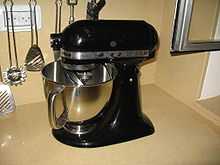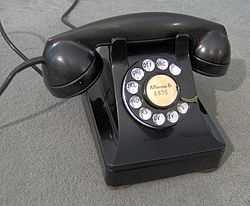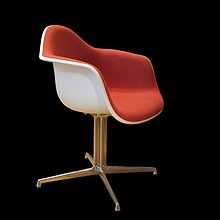Industrial design




Industrial design is the use of both applied art and applied science to improve the aesthetics, ergonomics, functionality, and/or usability of a product, and it may also be used to improve the product's marketability and even production. The role of an industrial designer is to create and execute design solutions for problems of form, usability, physical ergonomics, marketing, brand development, and sales.[2]
Industrial design can overlap significantly with engineering design, and in different countries the boundaries of the two concepts can vary, but in general engineering focuses principally on functionality or Utility of Products whereas industrial design focuses principally on aesthetic and user-interface aspects of products. In many jurisdictions this distinction is effectively defined by credentials and/or licensure required to engage in the practice of engineering.[3] "Industrial design" as such does not overlap much with the engineering sub-discipline of industrial engineering, except for the latter's sub-specialty of ergonomics.
History
The first use of the term "industrial design" is often attributed to the industrial designer Joseph Claude Sinel in 1919 (although he himself denied this in interviews), but the discipline predates 1919 by at least a decade. Christopher Dresser is considered the world's first industrial designer.[citation needed] Industrial design's origins lie in the industrialization of consumer products. For instance the Deutscher Werkbund, founded in 1907 and a precursor to the Bauhaus, was a state-sponsored effort to integrate traditional crafts and industrial mass-production techniques, to put Germany on a competitive footing with England and the United States.
The earliest use of the term may have been in The Art Union, A monthly Journal of the Fine Arts, 1839:[citation needed]
“Dyce’s report to the Board of Trade on foreign schools of Design for Manufactures. Mr Dyces official visit to France, Prussia and Bavaria for the purpose of examining the state of schools of design in those countries will be fresh in the recollection of our readers. His report on this subject was ordered to be printed some few months since, on the motion of Mr Hume.”
“The school of St Peter, at Lyons was founded about 1750 for the instruction of draftsmen employed in preparing patterns for the silk manufacture. It has been much more successful than the Paris school and having been disorganized by the revolution, was restored by Napoleon and differently constituted, being then erected into an Academy of Fine Art: to which the study of design for silk manufacture was merely attached as a subordinate branch. It appears that all the students who entered the school commence as if they were intended for artists in the higher sense of the word and are not expected to decide as to whether they will devote themselves to the Fine Arts or to Industrial Design, until they have completed their exercises in drawing and painting of the figure from the antique and from the living model. It is for this reason, and from the fact that artists for industrial purposes are both well paid and highly considered (as being well instructed men) that so many individuals in France engage themselves in both pursuits.”
The practical draughtsman's book of industrial design: was printed in 1853.
Robert Lepper helped to establish one of the country's first industrial design degree programs at Carnegie Institute of Technology.[4]
Education
Product design and industrial design overlap into the fields of user interface design, information design, and interaction design. Various schools of industrial design and design engineering specialize in one of these aspects, ranging from pure art colleges (product styling) through mixed programs of engineering and design, related disciplines such as exhibit design and interior design—to schools that almost completely subordinated aesthetic design to concerns of usage and ergonomics(the so-called functionalist school).[5]
University and Institutions
Degrees in industrial design are offered at universities worldwide and typically take four to five years of study. The study results in a Bachelor of Industrial Design (B.I.D.) or Bachelor of Science (B.Sc). Afterwards, the bachelor programme can be extended to postgraduate degrees such as Master of Design, Master of Fine Arts and others to a Master of Arts or Master of Science.
Definition of industrial design
Industrial design studies function and form—and the connection between product, user, and environment. Generally, industrial design professionals work in small scale design, rather than overall design of complex systems such as buildings or ships. Industrial designers don't usually design motors, electrical circuits, or gearing that make machines move, but they may affect technical aspects through usability design and form relationships. Usually, they work with other professionals such as marketers to identify and fulfill customer needs and expectations.
Industrial design (ID) is the professional service of creating and developing concepts and specifications that optimize the function, value and appearance of products and systems for the mutual benefit of both user and manufacturer.
Design, itself, is often difficult to describe to non-designers and engineers, because the meaning accepted by the design community is not made of words. Instead, the definition is created as a result of acquiring a critical framework for the analysis and creation of artifacts. One of the many accepted (but intentionally unspecific) definitions of design originates from Carnegie Mellon's School of Design, "Design is the process of taking something from its existing state and moving it to a preferred state." This applies to new artifacts, whose existing state is undefined, and previously created artifacts, whose state stands to be improved.
Design process


Although the process of design may be considered 'creative,' many analytical processes also take place. In fact, many industrial designers often use various design methodologies in their creative process. Some of the processes that are commonly used are user research, sketching, comparative product research, model making, prototyping and testing. These processes are best defined by the industrial designers and/or other team members. Industrial designers often utilize 3D software, computer-aided industrial design and CAD programs to move from concept to production. They may also build a prototype first and then use industrial CT scanning to test for interior defects and generate a CAD model. From this the manufacturing process may be modified to improve the product.
Product characteristics specified by industrial designers may include the overall form of the object, the location of details with respect to one another, colors, texture, form, and aspects concerning the use of the product. Additionally they may specify aspects concerning the production process, choice of materials and the way the product is presented to the consumer at the point of sale. The inclusion of industrial designers in a product development process may lead to added value by improving usability, lowering production costs and developing more appealing products.
Industrial design may also focus on technical concepts, products, and processes. In addition to aesthetics, usability, and ergonomics, it can also encompass engineering, usefulness, market placement, and other concerns—such as psychology, desire, and the emotional attachment of the user. These values and accompanying aspects that form the basis of industrial design can vary—between different schools of thought, and among practicing designers.
Industrial design rights
Industrial design rights are intellectual property rights that make exclusive the visual design of objects that are not purely utilitarian. A design patent would also be considered under this category. An industrial design consists of the creation of a shape, configuration or composition of pattern or color, or combination of pattern and color in three dimensional form containing aesthetic value. An industrial design can be a two- or three-dimensional pattern used to produce a product, industrial commodity or handicraft. Under the Hague Agreement Concerning the International Deposit of Industrial Designs, a WIPO-administered treaty, a procedure for an international registration exists. An applicant can file for a single international deposit with WIPO or with the national office in a country party to the treaty. The design will then be protected in as many member countries of the treaty as desired.
Examples of iconic industrial design

A number of industrial designers have made such a significant impact on culture and daily life that their work is documented by historians of social science.[citation needed] Alvar Aalto, renowned as an architect, also designed a significant number of household items, such as chairs, stools, lamps, a tea-cart, and vases. Raymond Loewy was a prolific American designer who is responsible for the Royal Dutch Shell corporate logo, the original BP logo (in use until 2000), the PRR S1 steam locomotive, the Studebaker Starlight (including the later iconic bulletnose), as well as Schick electric razors, Electrolux refrigerators, short-wave radios, Le Creuset French ovens, and a complete line of modern furniture, among many other items.
Richard A. Teague, who spent most of his career with the American Motor Company, originated the concept of using interchangeable body panels so as to create a wide array of different vehicles using the same stampings. He was responsible for such unique automotive designs as the Pacer, Gremlin, Matador coupe, Jeep Cherokee, and the complete interior of the Eagle Premier.
Viktor Schreckengost designed bicycles manufactured by Murray bicycles for Murray and Sears, Roebuck and Company. With engineer Ray Spiller, he designed the first truck with a cab-over-engine configuration, a design in use to this day. Schreckengost also founded The Cleveland Institute of Art's school of industrial design.
Oskar Barnack was a German optical engineer, precision mechanic, industrial designer, and the father of 35mm photography. He developed the Leica, which became the hallmark for photography for 50 years, and remains a high-water mark for mechanical and optical design.
Charles and Ray Eames were most famous for their pioneering furniture designs, such as the Eames Lounge Chair Wood and Eames Lounge Chair. Other influential designers included Henry Dreyfuss, Eliot Noyes, and Russel Wright.
Dieter Rams is a German industrial designer closely associated with the consumer products company Braun and the Functionalist school of industrial design.
Many of Apple's recent iconic products were designed by Sir Jonathan Ive.
See also
- Automotive design
- Chief Experience Officer (CXO)
- Communication design
- Core77
- Creative engineering
- Designer
- Emotional Design by Donald Norman
- Engineering design process
- Environmental design
- Experience design
- Form follows function
- Hague system
- Industrial Designers Society of America
- Interaction design
- Product design
- Product development
- Rapid prototyping
- Sensory design
- Transgenerational design
- TU Delft Faculty of Industrial Design Engineering
- WikID
Notes
- ^ See Dyson's autobiography Against The Odds, Pub Thomson 2002[7]
References
- ↑ "WE 300-series Types". Paul-f.com. 2012-08-11. Retrieved 2012-09-20.
- ↑ de Noblet, J., Industrial Design, Paris: A.F.A.A. (1993)
- ↑ http://www10.mcadcafe.com/nbc/articles/view_article.php?articleid=318078
- ↑ "Newsbriefs: Lepper show runs at Warhol." Carnegie Mellon Magazine. Winter 2002. Retrieved January 17, 2014.
- ↑ Pulos, Arthur J., The American Design Adventure 1940-1975, Cambridge, Mass:MIT Press (1988), p. 249 (ISBN 9780262161060)
- ↑
- ↑ Dyson, James (1997). Against the odds: An autobiography. London: Orion Business. ISBN 978-0-7528-0981-6. OCLC 38066046.
Further reading
- Objects of Desire: Design and Society Since 1750. Adrian Forty, Thames Hudson, May 1992. ISBN 978-0-500-27412-5.
- Design, Creativity and Culture, Maurice Barnwell, Black Dog, October 2011, ISBN 978 1 907317 408
- Industrial Design - New Frontiers, Denis A. Coelho (editor), InTech Open Access Publisher, November 2011. ISBN 978-953-307-622-5.
- Twentieth Century Limited: Industrial Design engineering in America, 1925 - 1939. Jeffrey Meikle. Philadelphia: Temple University Press, 1979.
External links
| Wikimedia Commons has media related to Product Design. |
| Wikiquote has a collection of quotations related to: Industrial design |
- U.S. Department of Labor's Handbook: Commercial and Industrial Designers
- Doodles, Drafts and Designs: Industrial Drawings from the Smithsonian (2004) Smithsonian Institution Libraries
- Industrial design history (in Spanish)